Outage casts light on dim outlook

THOUGH officials at the TT Electricity Commission (T&TEC) estimated Tuesday’s power outage affected only 30 per cent of its customers, the incident was nonetheless a worrying indication of continued or even increasing vulnerabilities in our infrastructure.
Coming exactly six months after a Trinidad-wide blackout which caused incredible disruption and resulted in millions of dollars in losses, this week’s incident will lead many to question what lessons have been learned from February’s event.
A Cabinet-appointed expert committee said the February 16 blackout, which affected all of Trinidad for a total of 12.5 hours, was due to a fungus-infected tree falling on wires.
That single event generated several ripple effects: a line oscillated and came into contact with another line circuit, which then shut down that circuit and isolated one of the main supplies of power.
That loss of power led to other facilities trying to compensate. Overwhelmed, they shut down in a cascading outage.
Despite this, the committee said the electricity network is robust, with reasonable redundancy, and is generally well-operated, even if no system is immune to failure. It found failures of management and recommended the construction of another line to effectively act as a backup linking key substations.
It seems implementing these matters is still a work in progress, with the new line due in 2023.
But if it is unusual for a single tree to be allowed to bring down an entire power system, Tuesday’s outage was due to a similarly unexpected and yet banal cause.
According to experts at T&TEC – who ruled out sabotage – there was a landslip at Rousillac. This shifted a key transmission tower, causing it to bend.
Not even residents of the area anticipated such an occurrence.
“We did not know about the landslip, because that is in the bush area,” one said. “When the electricity went off, we did not hear anything.”
Officials need to do a better job of identifying risks and implementing redundancy strategies.
While infrastructure cannot be expected to appear magically overnight, there is a clear need for urgency when it comes to putting measures in place to prevent outages, whether big or small.
Such events have become too common.
On August 6, some areas of Trinidad had no electricity, starting around 9 am. These outages were blamed on the generating plant of an independent power producer. Luckily, electricity was restored by the end of the day.
The Cabinet committee that probed February’s event also called for an annual review of the power system’s resilience. It may be that such reviews and inspections are needed more often.
Clearly, however, the more fundamental issue is the need for better infrastructure – and better management of that infrastructure, which should be given higher priority.


Comments
"Outage casts light on dim outlook"